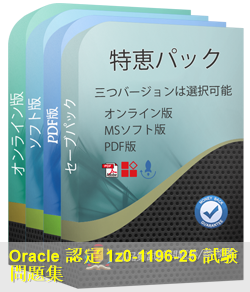GoShiken は 1z0-1196-25 試験「Oracle Utilities Customer to Meter and Customer Cloud Service 2025 Implementation Professional」のサンプル問題を無料で提供しています。購入する前、弊社の模擬試験画面や問題のクオリティー、使いやすさを事前に体験できます。
Oracle Utilities Customer to Meter and Customer Cloud Service 2025 Implementation Professional: 1z0-1196-25 試験
「Oracle Utilities Customer to Meter and Customer Cloud Service 2025 Implementation Professional」、1z0-1196-25試験であります、Oracle認定でございます。 最適な問題と解答をまとめられて、GoShiken はお客様の1z0-1196-25試験に計 50 問をまとめてご用意いたしました。1z0-1196-25試験の集結内容には、Oracle Cloud認定にあるエリアとカテゴリの全てをカバーしており、お客様の Oracle Utilities Customer to Meter and Customer Cloud Service 2025 Implementation Professional 試験認定合格の準備を手助けをお届けします。



リアルな1z0-1196-25テストエンジン
弊社のOracle Utilities Customer to Meter and Customer Cloud Service 2025 Implementation Professional受験資料はお客様がOracle 1z0-1196-25試験を受けるために必要なすべてのものが含まれています。詳細はOracle Utilities Customer to Meter and Customer Cloud Service 2025 Implementation Professional認証専門家側が研究して制作されて、彼らは業界の経験を利用して正確で論理的な制品を改良され続けています。
品質と価値のある1z0-1196-25試験問題
GoShiken練習試験Oracle 1z0-1196-25は認定された対象分野の専門家と公開された作成者のみを招いて、最高水準の技術的精度で作成されています。
1z0-1196-25試験合格を100%返金保証
お客様がもしGoShikenのテストエンジンを使って 1z0-1196-25 試験「Oracle Utilities Customer to Meter and Customer Cloud Service 2025 Implementation Professional」に不合格されました場合、弊社はお客様に購入金額を全額返金致します。
- 1z0-1196-25 試験に関する広範囲的な問題と解答
- 1z0-1196-25 試験問題集は事前使用できる
- 問題は業界の専門家によって調査されて、ほぼ100%正解率の検証済みの回答
- 1z0-1196-25 試験問題集は定期的に更新されます
- 本番試験を基づいてまとめられた 1z0-1196-25 問題集
- こちらの問題集は販売される前に複数回シミュレーション済み
- GoShiken で購入すると決める前に、無料で 1z0-1196-25 試験問題集のサンプルを試せます
365日無料アップデート
購入日から365日無料アップデートをご利用いただけます。365日後、1z0-1196-25問題集更新版がほしく続けて50%の割引を与えれます。
インスタントダウンロード
お支払い後、弊社のシステムは、1分以内に購入した1z0-1196-25問題集をあなたのメールボックスにお送りします。 2時間以内に届かない場合に、お問い合わせください。
100%返金保証
購入後60日以内に、1z0-1196-25試験に合格しなかった場合は、全額返金します。 そして、無料で他の試験問題集を入手できます。
ハイパスレート
近年、1z0-1196-25テスト連続は好評を博しており、すべての献身的な努力で99%の合格率に達しています。 より多くの労働者がより高い自己啓発を進めるための強力なツールとして、1z0-1196-25認定トレーニングは高度なパフォーマンスと人間中心の技術への情熱を追求し続けています。 さまざまな種類の受験者がOracle Utilities Customer to Meter and Customer Cloud Service 2025 Implementation Professional認定を受けるのをどのように手助けするかを理解するために多くの研究が行われてきました。 シラバスの変更および理論と実践における最新の動向に従って、Oracle Utilities Customer to Meter and Customer Cloud Service 2025 Implementation Professionalガイドの連続を修正して更新します。 私たちは、厳密な分析を通じて、近年のテストと業界の動向に基づいて1z0-1196-25認定トレーニングを行います。
信頼できる売り上げ後のサービス
最高の1z0-1196-25テスト連続を提供することにおける世界的なリーダーとして、我々は大多数の消費者に包括的なサービスを提供することに専念して、そして統合されたサービスを構築するよう努めます。 さらに、1z0-1196-25認定トレーニングアプリケーション、インタラクティブ共有、アフターサービスでも画期的な成果を上げました。 実際のところ、私たちの会社はすべてのクライアントのフィッティングソリューションに対する困難を考慮に入れています。 あなたが助けを必要とする限り、Oracle Utilities Customer to Meter and Customer Cloud Service 2025 Implementation Professionalガイドの連続に関する問題のいずれかに対処するための即時サポートを提供します。 いつでも利用可能です。 私たちの責任あるスタッフが質問に答えてくれます。
Oracle Utilities Customer to Meter and Customer Cloud Service 2025 Implementation Professional 認定 1z0-1196-25 試験問題:
1. When a request for usage is initiated for billing calculations, the system subsequently uses available meter reading data to calculate service quantities (often referred to as bill determinants). If these reads are later corrected (or replacement reads added), a Corrected Read Notification is instantiated. Which entity represents a Corrected Read Notification?
A) Usage Request
B) Measurement
C) Off Cycle Bill Generator
D) Correction Note
E) Usage Transaction
2. Which three statements are true regarding Financial Transaction creation algorithms?
A) They control how the payoff balance is affected.
B) They control when a Financial Transaction's details are ready to be posted to the General Ledger.
C) They control how the current balance is affected.
D) They control when a Financial Transaction is to be swept onto a bill.
E) They control if and how the General Ledger entries are created.
3. Usage calculations calculate service quantities (often referred to as bill determinants) for bill calculation purposes. Which option correctly specifies the valid entity or entities related to usage calculations?
A) Pre-Processing Usage Calculation Group, Usage Version Calculation Group, and Post-Processing Usage Calculation Group
B) Usage Version Calculation Group
C) Usage Calculation Group and Post-Processing Usage Calculation Group
D) Usage Calculation Group
E) Pre-Processing Usage Calculation Group and Usage Calculation Group
4. An implementation is starting an Advanced Meter Infrastructure (AMI) roll-out initiative and they plan to replace their legacy scalar TOU meters with smart meters. They wantto continue to bill for the same TOU periods and they do not want to change the rate being used. Which three actions should an implementation take to support this requirement?
A) Add the new usage calculation group to the Customer Rate Schedule extendable lookup for the rate.
B) Add a TOU mapping usage calculation rule to the existing usage calculation group.
C) Set up the new or existing usage calculation group to be identified dynamically by plug-in logic configured on the usage subscription if not configured already.
D) Add a new usage calculation group with a TOU mapping usage calculation rule.
E) Add the TOU mapping usage rule to the Customer Rate Schedule extendable lookup for the rate.
F) Set up the new usage calculation group to be identified dynamically by plug-in logic configured on the usage subscription's type if not configured already.
5. An implementation has the following requirements: Many customers are installing their own solar electrical generation equipment. When these customers generate more electricity than required for their own use, the surplus can be exported back to the power grid. To measure this generation, the utility has installed special scalar devices at customers' premises. These devices have separate registers to measure the energy generated (export) and the energy received (import) from the power grid. Both types of read will be stored in kWh, but the import is subtractive and export is consumptive. Which solution should an implementation choose to configure the measuring component types for these specific requirements?
A) Create two service points, one for subtractive import measuring component and the other for consumptive export, that will be linked to one scalar device.
B) Create one new measuring component type for creating a new measuring component that will be linked to two different scalar devices (one device for import and the other for export).
C) Create two new measuring component types, one for subtractive import and the other for consumptive export, to enable the creation of two measuring components that will be linked to one scalar device.
D) Create one new measuring component type for creating two measuring components, one measuring component for subtractive import and the other for consumptive export, that will be linked to one scalar device.
質問と回答:
| 質問 # 1 正解: B | 質問 # 2 正解: B、C、E | 質問 # 3 正解: D | 質問 # 4 正解: B、C、D | 質問 # 5 正解: C |


 0 お客様のコメント
0 お客様のコメント